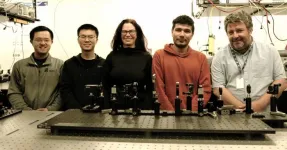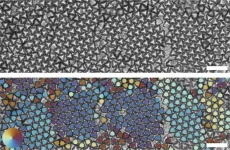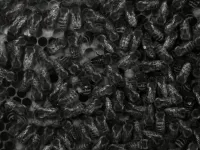(Press-News.org) Research Highlights:
A large study of residents in Ningbo, China, a major city of more than 8.2 million residents, found that exposure to more artificial, outdoor, nighttime light was associated with a higher risk of conditions that affect brain health.
Excessive exposure to air pollution and artificial, bright light at night were both independently linked to a higher risk of developing cerebrovascular disease and having a stroke.
Embargoed until 1 p.m. CT/2 p.m. ET, Monday, March 25, 2024
DALLAS, March 25, 2024 — People continuously exposed to bright, artificial light at night may be at increased risk of developing conditions that affect blood flow to the brain and having a stroke, according to research published today in Stroke, the peer-reviewed scientific journal of the American Stroke Association, a division of the American Heart Association.
Bright, outdoor lights are used at night to enhance the visibility of the environment, improving human safety and comfort. However, the excessive use of artificial light has resulted in about 80% of the world's population living in light-polluted environments, according to the study’s authors.
While previous studies have linked increased exposure to bright, artificial light at night to the development of cardiovascular disease, this is one of the first studies to explore the relationship between exposure to light pollution at night and the potential risk to brain health and stroke.
“Despite significant advances in reducing traditional cardiovascular risk factors such as smoking, obesity and Type 2 diabetes, it is important to consider environmental factors in our efforts to decrease the global burden of cardiovascular disease,” said one of the corresponding authors Jian-Bing Wang, Ph.D., a researcher in the department of public health and department of endocrinology of the Children's Hospital, Zhejiang University School of Medicine and the National Clinical Research Center for Children’s Health in Hangzhou, China.
In a review of 28,302 adults living in China, exposure to residential outdoor nighttime light was assessed by satellite images that mapped light pollution. Cases of stroke were confirmed by hospital medical records and death certificates.
The analysis of data including six years of follow-up with participants found:
1,278 people developed cerebrovascular disease, including 777 ischemic (clot-caused) stroke cases and 133 hemorrhagic (bleeding) stroke cases.
People with the highest levels of exposure to outdoor light at night had a 43% increased risk of developing cerebrovascular disease compared to those with the lowest levels of exposure.
People with the highest levels of exposure to particulate matter 2.5 (PM2.5 is primarily emissions from combustion of gasoline, oil, diesel fuel or wood) had a 41% increased risk of developing cerebrovascular disease compared to participants with the lowest levels of exposure to PM2.5.
Participants with the highest levels of exposure to PM10 (PM10 is primarily from dust and smoke) had a 50% increased risk of developing cerebrovascular disease compared to those with the lowest exposure to PM10.
Participants with the highest exposure to nitrogen oxide (emissions from cars, trucks and buses, power plants and off-road equipment) had a 31% higher risk of developing cerebrovascular disease compared to those with the lowest exposure.
Of note, an additional analysis that included both outdoor light at night and pollution found that the associations with increased risk of cerebrovascular disease persisted, except for ischemic stroke.
“Our study suggests that higher levels of exposure to outdoor artificial light at night may be a risk factor for cerebrovascular disease,” Wang said. “Therefore, we advise people, especially those living in urban areas, to consider reducing that exposure to protect themselves from its potential harmful impact.”
Artificial sources of light include fluorescent, incandescent and LED light sources. Continuous exposure to these light sources at night can suppress melatonin production, a hormone that promotes sleep. This can disrupt the 24-hour internal clock in people and impair sleep. People with poor sleep, compared to good sleepers, are more likely to experience worse cardiovascular health over time, according to the study. The American Heart Association’s Life’s Essential 8 includes healthy sleep as one of the eight healthy lifestyle behaviors and health measures that drive optimal cardiovascular health.
“We need to develop more effective policies and prevention strategies to reduce the burden of disease from environmental factors such as light as well as air pollution, particularly for people living in the most densely populated, polluted areas around the world,” Wang said.
Study background and details:
The analysis was conducted from 2015 to 2021 and included adults without cardiovascular disease who lived in Ningbo, a major port and industrial city on China’s east coast, with a population of more than 8.2 million people according to the 2020 Chinese national census.
The average age of study participants was 62 years and about 60% were women.
Participants were enrolled from 2015-2018 and followed for up to six years for cerebrovascular disease, ischemic stroke and hemorrhagic stroke.
People with unavailable addresses or error records, missing covariate data (data not included in the original study that might alter outcomes), extreme levels of exposure to outdoor light at night, previously diagnosed with cerebrovascular disease at enrollment and within 1 year after enrollment were excluded from the analysis.
There were several limitations to the study, including that it did not obtain data on indoor lighting products and shading measures such as blackout curtains used by participants during nighttime. Additionally, satellite-based products rarely capture blue light sources, which may lead to an underestimated association between outdoor light at night and cerebrovascular disease; and the population studied was from one city in China, therefore the findings may not apply to people in other communities with different exposure to outdoor light at night. Larger prospective studies are needed to confirm these findings.
Co-authors, disclosures and funding sources are listed in the manuscript.
Studies published in the American Heart Association’s scientific journals are peer-reviewed. The statements and conclusions in each manuscript are solely those of the study authors and do not necessarily reflect the Association’s policy or position. The Association makes no representation or guarantee as to their accuracy or reliability. The Association receives funding primarily from individuals; foundations and corporations (including pharmaceutical, device manufacturers and other companies) also make donations and fund specific Association programs and events. The Association has strict policies to prevent these relationships from influencing the science content. Revenues from pharmaceutical and biotech companies, device manufacturers and health insurance providers and the Association’s overall financial information are available here.
Additional Resources:
Multimedia is available on the right column of release link https://newsroom.heart.org/news/more-exposure-to-artificial-bright-outdoor-nighttime-light-linked-to-higher-stroke-risk?preview=5d799e3293e9f61b620bb951f052cb0e
After March 25, view the manuscript online.
AHA news release: Particulate air pollution a growing risk for premature CVD death and disability worldwide (Aug. 2023)
AHA news release: Long-term exposure to low levels of air pollution increases risk of heart and lung disease (Feb. 2021)
AHA news release: Years of exposure to air pollution and road traffic noise may raise heart failure risk (Oct. 2021)
AHA news release: More green spaces help boost air quality, reduce heart disease deaths (Nov. 2020)
Follow AHA/ASA news on Twitter @HeartNews
Follow news from the Stroke journal @StrokeAHA_ASA
###
About the American Stroke Association
The American Stroke Association is devoted to saving people from stroke — the No. 2 cause of death in the world and a leading cause of serious disability. We team with millions of volunteers to fund innovative research, fight for stronger public health policies and provide lifesaving tools and information to prevent and treat stroke. The Dallas-based association officially launched in 1998 as a division of the American Heart Association. To learn more or to get involved, call 1-888-4STROKE or visit stroke.org. Follow us on Facebook, Twitter.
END
More exposure to artificial, bright, outdoor nighttime light linked to higher stroke risk
Air pollution and nighttime outdoor light each were associated with harmful effects on brain health, finds new study in the journal Stroke
2024-03-25
ELSE PRESS RELEASES FROM THIS DATE:
AACR: Progress treating pancreatic cancer, immunotherapy for head and neck cancers, potential biomarker for aggressive neuroendocrine carcinomas and more
2024-03-25
Investigators from the UCLA Health Jonsson Comprehensive Cancer Center will discuss the latest breakthroughs and cutting-edge science at the annual meeting of the American Association for Cancer Research (AACR), which attracts more than 20,000 oncology professionals from around the world.
The annual meeting will feature more than 40 regular, late-breaking and clinical trial abstracts from UCLA physicians and scientists, who will present their latest work in key areas of translational and basic scientific ...
Insights from patient who cleared hepatitis C could lead to vaccine
2024-03-25
ITHACA, N.Y. -- By studying individuals who spontaneously clear hepatitis C infections, a team of researchers has identified viable vaccine targets for a disease that infects 70 million worldwide with case numbers increasing every year.
It turns out that a quarter of people who become infected with the hepatitis C virus clear the infection on their own without treatment, while the remaining three-quarters of people develop chronic infections that can last for years. The blood-borne disease – which causes liver cirrhosis, liver ...
Uncovering the mystery of Dorset’s Cerne Giant
2024-03-25
For centuries, the Cerne Giant, a figure carved into a hillside in Dorset depicting a nude man carrying a club and stretching some 180 feet high, has fascinated locals and visitors to the area. The history of the giant, however, and in particular, its age, has long been a mystery. A new paper in Speculum: A Journal of Medieval Studies proposes that the Cerne Giant can in fact be dated to the early Middle Ages, and, as a result, its cultural context and significance more clearly understood.
“The Cerne Giant in its Early Medieval Context,” by authors Thomas Morcom and Helen Gittos, acknowledges that previous attempts to date the giant placed ...
RCSI research identifies promising drug combination for multiple myeloma treatment
2024-03-25
25 March 2024: RCSI research has found that venetoclax, a medication currently approved for leukaemia, has benefits for patients with multiple myeloma when used in combination with another drug. This discovery offers a new avenue of treatment options for the currently incurable disease.
Multiple myeloma (MM) is a type of blood cancer that is newly diagnosed in around 400 people in Ireland each year. Despite treatment advances in recent years, it remains incurable. The search for innovative treatment strategies is crucial, particularly for patients whose cancer is resistant to standard care.
In the new study published in Haematologica, researchers at the RCSI Department of ...
Confusing assistance requirements contribute to food insecurity among college students
2024-03-25
Philadelphia, March 25, 2024 – Food insecurity among college students is associated with negative physical and mental health and lower academic performance and graduation rates. A recent research study in the Journal of Nutrition Education and Behavior, published by Elsevier, investigates why over half of college students eligible for the Supplemental Nutrition Assistance Program (SNAP)—the nation’s largest food assistance program—do not apply.
Lead study author Suzanna M. Martinez, PhD, MS, Department of Epidemiology and Biostatistics, University of California San Francisco, explained, “In California, ...
Pushing back the limits of optical imaging by processing trillions of frames per second
2024-03-25
Professor Jinyang Liang’s team is advancing in imaging speed with a new ultrafast camera system.
Pushing for a higher speed isn’t just for athletes. Researchers, too, can achieve such feats with their discoveries. This is the case for Jinyang Liang, Professor at the Institut national de la recherche scientifique (INRS), and his team, whose research results have recently been published in Nature Communications.
The group based at INRS’ Énergie Matériaux Télécommunications Research Centre has developed a new ultrafast camera system that can capture up to 156.3 trillion ...
Patient recovery after surgery for esophageal cancer isn’t influenced by using standard or keyhole incisions
2024-03-25
New research has found no evidence of a difference between recovery time and complications when comparing standard and keyhole surgical incisions for the treatment of oesophageal cancer (cancer of the gullet). The study, led by the University of Bristol Medical School and published in the British Journal of Surgery, showed surgeons treating patients with oesophageal cancer do not need to change their practice if they have a strong preference for either procedure type.
Oesophageal cancer is the tenth most common cancer globally. It causes one in 18 cancer-related deaths. ...
COVID-19 pandemic has left an enduring imprint on colorectal cancer surgery
2024-03-25
Key Takeaways
In a retrospective analysis of 105,517 patients with colorectal cancer, researchers found that colorectal cancer surgical cases fell by 17.3% during the first year of the pandemic.
Patients who underwent surgery for colorectal cancer in 2020 displayed more advanced stages of cancer compared to those treated in 2019.
The authors attribute these findings to multiple factors, including delays in screening, fear of COVID-19 exposure that may have prevented some people from seeking care, and disparities in cancer care that were likely exacerbated during the pandemic.
CHICAGO: While the COVID-19 pandemic is no longer considered a public ...
Elusive 3D printed nanoparticles could lead to new shapeshifting materials
2024-03-25
In nanomaterials, shape is destiny. That is, the geometry of the particle in the material defines the physical characteristics of the resulting material.
“A crystal made of nano-ball bearings will arrange themselves differently than a crystal made of nano-dice and these arrangements will produce very different physical properties,” said Wendy Gu, an assistant professor of mechanical engineering at Stanford University, introducing her latest paper which appears in the journal Nature Communications. “We’ve used a 3D nanoprinting technique to produce one of the most promising ...
Bees use antennae to decode hive mates’ dances in the dark
2024-03-25
Scientists have discovered how honeybees can decipher dances by their hive mates that relay directions to food.
The findings reveal how, in the complete darkness of the hive, each bee uses its antennae to help interpret the information communicated through the dances.
It has been known for decades that honeybees do so-called waggle dances, in which their movements and orientation on the honeycomb signal the direction and distance to food outside the hive. However, until now, it was unclear how the bees gathered around a waggle dancer make sense of the information.
Gaining greater insights into how bees communicate could help scientists to better understand the effects of ...
LAST 30 PRESS RELEASES:
Eye for trouble: Automated counting for chromosome issues under the microscope
The vast majority of US rivers lack any protections from human activities, new research finds
Ultrasound-responsive in situ antigen "nanocatchers" open a new paradigm for personalized tumor immunotherapy
Environmental “superbugs” in our rivers and soils: new one health review warns of growing antimicrobial resistance crisis
Triple threat in greenhouse farming: how heavy metals, microplastics, and antibiotic resistance genes unite to challenge sustainable food production
Earthworms turn manure into a powerful tool against antibiotic resistance
AI turns water into an early warning network for hidden biological pollutants
Hidden hotspots on “green” plastics: biodegradable and conventional plastics shape very different antibiotic resistance risks in river microbiomes
Engineered biochar enzyme system clears toxic phenolic acids and restores pepper seed germination in continuous cropping soils
Retail therapy fail? Online shopping linked to stress, says study
How well-meaning allies can increase stress for marginalized people
Commercially viable biomanufacturing: designer yeast turns sugar into lucrative chemical 3-HP
Control valve discovered in gut’s plumbing system
George Mason University leads phase 2 clinical trial for pill to help maintain weight loss after GLP-1s
Hop to it: research from Shedd Aquarium tracks conch movement to set new conservation guidance
Weight loss drugs and bariatric surgery improve the body’s fat ‘balance:’ study
The Age of Fishes began with mass death
TB harnesses part of immune defense system to cause infection
Important new source of oxidation in the atmosphere found
A tug-of-war explains a decades-old question about how bacteria swim
Strengthened immune defense against cancer
Engineering the development of the pancreas
The Journal of Nuclear Medicine ahead-of-print tip sheet: Jan. 9, 2026
Mount Sinai researchers help create largest immune cell atlas of bone marrow in multiple myeloma patients
Why it is so hard to get started on an unpleasant task: Scientists identify a “motivation brake”
Body composition changes after bariatric surgery or treatment with GLP-1 receptor agonists
Targeted regulation of abortion providers laws and pregnancies conceived through fertility treatment
Press registration is now open for the 2026 ACMG Annual Clinical Genetics Meeting
Understanding sex-based differences and the role of bone morphogenetic protein signaling in Alzheimer’s disease
Breakthrough in thin-film electrolytes pushes solid oxide fuel cells forward
[Press-News.org] More exposure to artificial, bright, outdoor nighttime light linked to higher stroke riskAir pollution and nighttime outdoor light each were associated with harmful effects on brain health, finds new study in the journal Stroke



